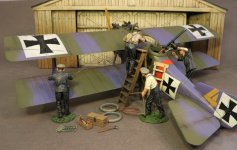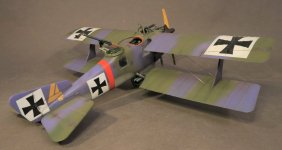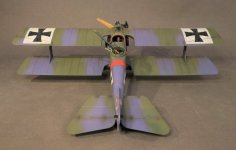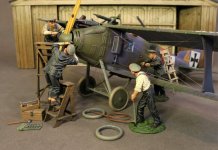NEW RELEASES FOR JUNE 2018
THE GREAT WAR 1914-1918
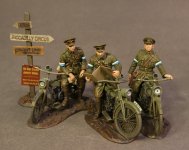
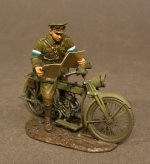
GWB-19C
THE GREAT WAR, 1914-1918,
Royal Engineers Signal Service(RESS),
DESPATCH RIDER ON MOTORBIKE,
(1pc)
In the British Army, motorcycle despatch riders were first used in the World War I by the Royal Engineers Signal Service. When the War Department called for motorcyclists to volunteer with their machines for despatch work at the start of August 1914, the response was huge
The London office had 2000 more applicants than places, and a similar response was reported in regional centres around the country. If a rider and machine were approved then £10 was paid immediately, £5 to be paid on discharge (unless due to misconduct), and pay was 35s per week. The motor cycle would be taken over at valuation price, or would be replaced with a new one at the close of operations. Enlistment was for one year or as long as the war might last. The preference was for 500cc single cylinder machines and the horizontally-opposed twin cylinder. All machines had to have a "change speed gear". A list of spare parts was also required to be carried.
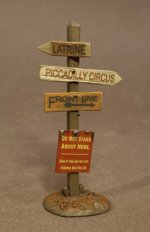
GWB-19D
THE GREAT WAR, 1914-1918,
SIGNPOST.
(1pc)
**PLEASE NOTE A NEW EXCITING GREAT WAR SET WILL BE PREVIEWED AT THE ONTARIO MODEL SOLDIER SOCIETY ANNUAL SHOW IN TORONTO ON 16th JUNE 2018**
THE GREAT WAR 1914-1918


GWB-19C
THE GREAT WAR, 1914-1918,
Royal Engineers Signal Service(RESS),
DESPATCH RIDER ON MOTORBIKE,
(1pc)
In the British Army, motorcycle despatch riders were first used in the World War I by the Royal Engineers Signal Service. When the War Department called for motorcyclists to volunteer with their machines for despatch work at the start of August 1914, the response was huge
The London office had 2000 more applicants than places, and a similar response was reported in regional centres around the country. If a rider and machine were approved then £10 was paid immediately, £5 to be paid on discharge (unless due to misconduct), and pay was 35s per week. The motor cycle would be taken over at valuation price, or would be replaced with a new one at the close of operations. Enlistment was for one year or as long as the war might last. The preference was for 500cc single cylinder machines and the horizontally-opposed twin cylinder. All machines had to have a "change speed gear". A list of spare parts was also required to be carried.

GWB-19D
THE GREAT WAR, 1914-1918,
SIGNPOST.
(1pc)
**PLEASE NOTE A NEW EXCITING GREAT WAR SET WILL BE PREVIEWED AT THE ONTARIO MODEL SOLDIER SOCIETY ANNUAL SHOW IN TORONTO ON 16th JUNE 2018**


